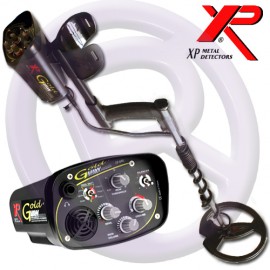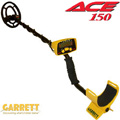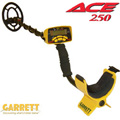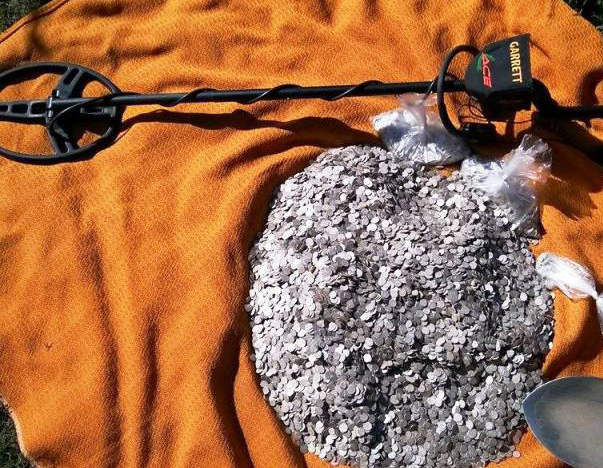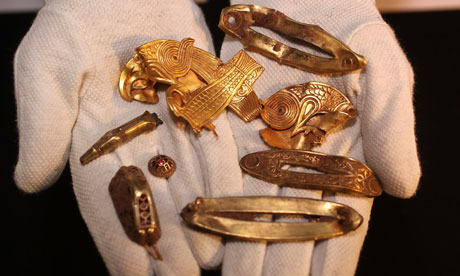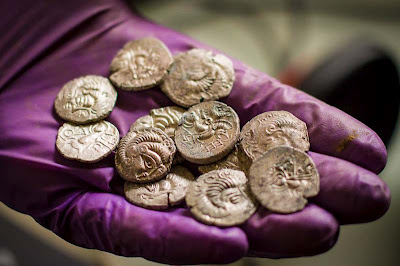XP Goldmaxx Power Field Test By John Lynn
The buying of a detector has always been down to either having heard about it through the grape vine, or reading the reports when a new detector hits the market. Once purchased, a read through the manual, a quick tryout of the machine with a few objects and then out on the fields. Only then will you start finding the faults and experience difficulties with the detector, some just requiring another read of the manual, others an inbuilt characteristic that hadn’t been mentioned with all the hype. This report will have a different format, instead of the usual copying out of the manual to give a description of the different functions of the detector; I will be testing those functions at home and in the field, giving an assessment, by seeing it through the eyes of a new owner and what he will come up against. All machines find, it’s how good and the ease with which they do it that counts. Nigel at Regton asked me to test the new chipped GoldMaxx version and allowed me plenty of time to do so. Tone i.d. has always had problems on this type of mineralised ground, so it would prove interesting. I don’t think I need to go into the assembling of the GoldMaxx, suffice to say it was easy and build quality is first rate, with attention paid to the known fault areas with detectors. The machine is well balanced and light enough to use all day. Running at 18KHz and powered by 8 X 1.5 volts batteries in two drop in pods. These have a working life of 70 hours, the nimh rechargeables drop to 30hours. I do think that there could be some improvement with the instruction manual, parts of it need to be updated to correct English with a little more in depth explanations to be fully understood.
A cautionary tale
After reading the manual, I spent a couple of hours in my home trying out numerous objects and settings to familiarise myself with the controls. Having got what I thought was an understanding; I took it out to the back garden. Mine is a relatively new house with a great deal of the builders rubbish beneath the lawn, at pre-set positions the detector was going absolutely bananas. With the amount of tones coming from the machine,
there were kids in the street looking for the ice cream van! Turning the sensitivity right back quietened things considerably, not a very auspicious start! Having recovered from this, it became a question of taking it to any spare patch of land and spending a great deal of time trying to get to grips with the detector, understanding was the issue, finding was secondary. Eventually as more of my land became available, I was able to try out the detector over a period of a couple of months, the results of which are as follows. The GoldMaxx can be run using tone i.d. or standard motion discrimination, these work independently of each other. As mentioned earlier, tone i.d. has never worked properly on my fields because of the heavy mineralisation. I have to say that the GoldMaxx is the first to do so with no problems. On the tone i.d. controls, Double or triple tones. A two-way switch enables double or triple tones, with the double tone, small iron will be low, with a clear high tone for the good stuff; there is no mistaking a good target, the deeper the coins, the higher the pitch they develop: even when close to any nails. Worked in conjunction with the silencer on 0 or 1 and sweeping slower in bad areas, target separation has been bordering on exceptional. The triple tone will give a higher pitch than the double on coins, with a medium tone for less conductive metals, but early during the test period I did find it confusing using either of the tones over the deeper medium size iron where they gave out a medley of tones (Could it be a coin near iron?) This however was down to me and my learning curve of the GoldMaxx. Approaching the target from a different direction helped with identification. One area where the triple tone scored better was on coke, the bane of many detectorists. With the note coke gives in double tone, it’s very hard to distinguish from that of a coin. Using the triple tone, a silver coin
signal is markedly higher than the coke, but a roman bronze minim isn’t. (See conventional disc.). I also found that by switching from one tone to the other over iffy signals helped with identification. Whilst on the subject of tones, the higher pitch of the innovative headphones supplied, gave a far superior signal for this machine than my more expensive ones. Very light and cool in the summer months too! I don’t believe that they will stand up to a lot of misuse though. The GoldMaxx can also be used as a conventional silent-search discriminating detector. When using the Discrimination, the tones, silencer and iron volume will be de-activated. With this system the iron discrimination is spread over a wide band starting from all metal on 0, nails are lost between 5 or 6, with full discrimination still being able to pull a cut half of Henry 2nd with very slight depth loss. This enables a lot more user control than many other detectors. Larger Iron will come through and if at depth, is hard at times to differentiate from a good signal. Changing to tone i.d. with the iron level will verify it is iron. Conversely it is very easy when in tone i.d. to switch to discrimination to verify signals. On full discrimination coke is lost whilst still being able to pull hammered and roman minims. Normal disc. is without doubt the quieter of the two sets of discrimination with no discernable differences in depth ability.
The Silencer
The wording is misleading in the manual when it talks of false signals caused by iron, although this quite rightly implies some inbuilt discrimination. I have come to the conclusion that the silencer with its 3-position switch, works on the same discrimination principal as bottle cap reject. This is for nails and small iron only, the larger the iron, the less the effect. (This is where the iron volume level takes over.) Running the coil over a 2-inch nail, in the 0 position, will give a certain amount of discrimination amounting to a broken signal. Switching to positions 1 then 2 will increase the rejection to “lose” the nail, albeit at the expense of losing a little of the response speed, at which this detector is now the fastest I have come across. Depth loss even on 2 is negligible. In use on 0, small iron will give an easy identifiable “spit” or a very brief chopped signal. Switching first to 1, then if necessary 2 will eradicate this smaller stuff; also by using 1 or 2, Tone i.d. is improved on the worst sites. Do not be confused by people saying that the silencer gets rid of ground chatter, it doesn’t, the only thing to get rid of ground chatter is a more positive ground balance! Which leads me nicely to ground balance. “Its ground balance Jim, but not as we know it”. The pre-set mark will eliminate hot rocks and other mineralised objects such as certain pottery. Holding the coil for 5 seconds in the air, away from the ground when first switching on, ground balances the detector correctly. On other detectors with a 10-turn ground adjust set correctly; to eliminate hot rocks requires a further turn to a turn and a half more positive with an ensuing loss of depth. So for those people where hot rocks aren’t a problem, by turning the control to the left of pre-set, this will gain more depth. For my land, I found this to be where the red segment starts, about the 11o’clock position, (mineralisation allowing). Bear in mind however, too far left of the pre-set will result in loss of discrimination and false signals caused by negative ground balance. Even further will lead to the detector sounding off if the coil scuffs the ground. If hot rocks do become too annoying, run one over the coil and turn the ground balance to the right until the sound disappears. Too far right will result in loss of depth. After saying all that, for those new to the machine, stay at the pre-set mark, it will be more stable and give better discrimination. Keep to this, even with a change of coils.
The Iron Volume
To begin with I was bemoaning the fact that the GoldMaxx didn’t have a constant threshold and an All-metal mode to suss iron quickly. Large deep iron was coming through and to my ears as a good signal, but after awhile the more I used the Iron volume and understood it better, the quicker and easier it became. Without the volume control, iron in the first few inches below the surface will give a low pitch, however, the deeper or larger it is, and the tone changes to a higher single or double pitch. With the iron volume in use, anything ferrous gives a distinctive low buzz, the deeper or larger the object, the more you need to increase the iron volume level to the right to identify it. I found that on large pieces such as horseshoes, if the coil was about a foot away it would give a good signal, then the volume control kicked in gradually became worse the closer it went to the iron. Eventually I came to understand that the size of the target had overpowered the detector and not a good and a bad signal in close proximity. If the ground is very mineralised and lots of iron, having too high a sensitivity setting will cause the iron volume to sound out (slightly) on a good signal. I did try the ground balance a little more positive and this helped but only partially. Reducing the sensitivity will cure this. Some detectorists will have the iron volume control at their preferred settings as soon as they start detecting, but I found that if the control box was hip-mounted for ease of access, I could run the iron volume on zero and then use it to check out the individual “not sure’s”. With more ferrous debris I found a setting about 9 or 10 0’clock worked well, then turning it higher on the individual larger pieces when necessary. The use of the volume control does not affect depth capabilities.
The coil
With the amount of mineralisation in the ground around here, the higher kHz machines (17,18and19) cry out for a DD widescan coil. This is a really good one, with very little “side-loss” to nearly maximum depth, robust, but light enough to swing all day. It combines the handling of mineralisation with good depths and obviously with this type of coil, target acquisition doesn’t have to rely on just the coil centre.There is no pinpoint mode, so sweeping the coil at 90 degrees to the target is necessary. By lifting the coil and just getting a signal, placed the object dead centre each time.
Conclusions
What do we all want from detectors, depth? Of course, without the need to dig a lot of iron. Also the ability to find the tiny stuff amongst iron, whilst handling bad mineralisation. Until now I’ve had to use more than one machine to accomplish this. So it’s a tall order for one, but I have found that used correctly, this detector has those capabilities. To be honest the first few days I used the GoldMaxx I didn’t like it because I didn’t understand it. In my ignorance I thought it was “gimmicky”, information was at times misleading, add to that alien words like “silencer” and “iron volume”; it was a new ball game. However after understanding the capacities of every control and how they worked in conjunction with each other, it not only became a lot clearer, but also left me admiring the thinking behind it. It reached the stage where I was going out not to find, but seeing just what else the detector could do. To achieve the results that this machine is capable of, will require time and more than a little patience; but then isn’t that the case with all good detectors? For those dyed in the wool, switch on and go, silent search merchants, this detector will not be for them. Using the tone i.d. system, everything will be heard, apart from small ferrous, yes it does have a perfectly good normal disc system, but it’s not half as interesting! (Or as informative) To get the very best results out of the detector, a slower sweep speed is needed; I don’t recommend using this to go belting across the fields. One of the areas where the GoldMaxx impressed me most has been the response speed and target separation, it really is exceptional. Normally to achieve results this good would be at the expense of depth. Not so in this case, I noticed a marked improvement in depths over my other detectors, even on the likes of cut halves and quarters. With such good results obtained from the standard widescan coil on mineralised and ferrous areas, I can imagine that the addition of the elliptical would be of real benefit on the roman sites etc. Iron, deep or otherwise was identified with the tone i.d. controls, even some iron washers. To begin with though, I did have difficulties at times “sussing” out signals. Coke problems should be a thing of the past by using the discrimination, without loss of coinage. I found the double tone easier to use and when over the target, if necessary, checking the signal with the triple, then if needed on occasions the discrimination mode. Differences in depth between the two discriminating modes were negligible. Whether hip-mounted or not, the detector has perfect balance and is Very light. I was able to use it for up to 10 hours at a time without the feeling that my arm was dropping off. From dislike, to like? If I have given the impression that this machine has “grabbed” me your right, would I recommend it?
I now own one! ‘Nuff said.
Reproduced with the kind permission of Treasure Hunting Magazine.
John Lynn
